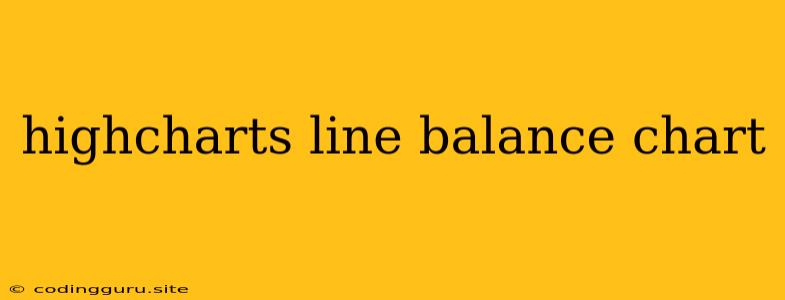Unveiling the Power of Highcharts Line Balance Charts: A Comprehensive Guide
Highcharts, the renowned charting library, offers a plethora of chart types to visualize data effectively. Among them, Highcharts line balance charts stand out as a powerful tool for representing data that fluctuates around a specific baseline or target value. This type of chart is particularly valuable in scenarios where you need to demonstrate the deviation of values from a reference point, making it ideal for analyzing financial performance, inventory levels, and other metrics that require a clear understanding of balance.
What is a Highcharts Line Balance Chart?
A Highcharts line balance chart, also known as a balance line chart, is a type of chart that uses a line to depict the evolution of a data series over time. The key distinction lies in the presence of a balance line, which acts as a visual reference point. This line represents a target value, an average, or any other relevant benchmark. The data series line then fluctuates around this balance line, highlighting deviations and trends in relation to the chosen reference point.
How to Create a Highcharts Line Balance Chart: A Step-by-Step Guide
Creating a Highcharts line balance chart is straightforward thanks to Highcharts' intuitive API. Follow these steps to craft your own balance chart:
- Include the Highcharts Library: Begin by incorporating the Highcharts library into your HTML file. You can either download the library or use a CDN link.
- Prepare Your Data: Organize your data into an array of objects, where each object represents a data point. The object should include properties for the timestamp (x-axis) and the corresponding data value (y-axis).
- Define Chart Options: In your JavaScript code, create a
Highcharts.chart()object and configure its properties to customize your Highcharts line balance chart. Key settings include:- Chart Type: Set the
typeproperty to'line'. - Data Series: Define an array of data series, ensuring that each series has its own
dataarray containing your prepared data points. - Balance Line: Add a
plotLinesarray to theyAxisconfiguration. Each object in this array represents a horizontal line. Specify thevalueto set the position of your balance line, and customize other properties like color and width for visual clarity.
- Chart Type: Set the
- Render the Chart: Call the
Highcharts.chart()function to render your Highcharts line balance chart within your HTML container.
Examples of Highcharts Line Balance Charts:
Example 1: Financial Performance
Imagine you're analyzing a company's monthly sales figures against a set revenue target. A Highcharts line balance chart would effectively illustrate how sales fluctuate around the target value. The balance line would represent the target revenue, while the data series line would depict actual sales over time. This visual representation would clearly show whether the company is exceeding or falling short of its target.
Example 2: Inventory Management
In a warehouse setting, you might want to monitor inventory levels against a desired optimal stock level. A Highcharts line balance chart would be perfect for this. The balance line would represent the optimal stock level, while the data series line would track actual inventory levels over time. Deviations from the optimal level would be immediately apparent, allowing for timely adjustments to prevent stockouts or overstocking.
Benefits of Using Highcharts Line Balance Charts:
1. Enhanced Visualization: Highcharts line balance charts provide a visually compelling way to present data, making complex trends and deviations easily understandable.
2. Improved Data Interpretation: By comparing data series to a balance line, you gain a deeper understanding of how values fluctuate around a reference point, enabling informed decision-making.
3. Flexibility: You can customize the balance line with various colors, styles, and labels to communicate your specific message effectively.
4. Interactive Exploration: Highcharts provides interactive features such as zooming, panning, and tooltips, allowing users to explore the data in detail.
Conclusion:
Highcharts line balance charts are a powerful tool for presenting data that fluctuates around a specific value. They offer a clear visual representation of deviations, making it easier to understand trends and make informed decisions based on the data. By utilizing the intuitive features of the Highcharts library, you can create dynamic and informative Highcharts line balance charts that effectively communicate your data insights.
